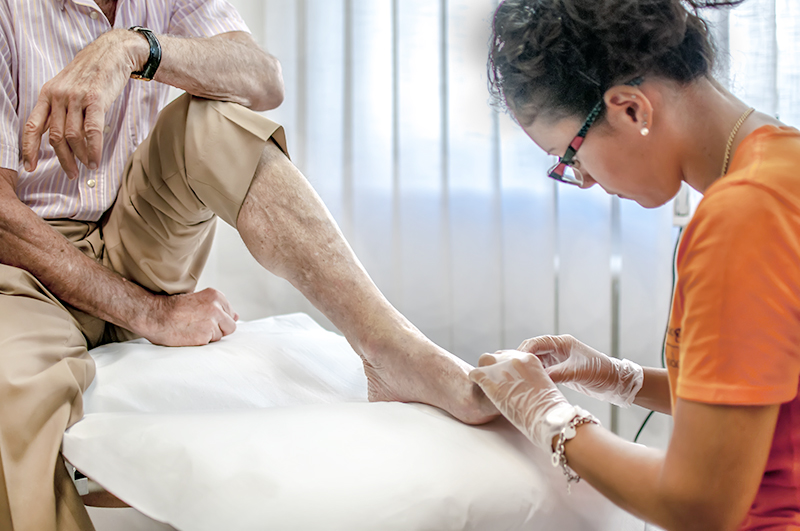Daily Foot Care Tips for Diabetics
Regular foot care is important for those with diabetes. That being said, uncontrolled glucose levels can damage nerves. Therefore, problems in the peripheral parts of the body can develop.
Without a daily foot-care routine, however, complications develop before you know. Small wounds can go unnoticed for weeks. People don’t realize until an infection develops. This can lead to serious complications like gangrene. Even amputation.
Daily foot care is the best way to avoid complications. Although, you can identify problems early. In fact, 85% of amputations can be prevented when wounds are treated quickly. Therefore, it’s important to check your feet daily. And see your podiatrist every two or three months too.
Tips for Regular Foot Care
There are things you need to do each week and each day. This is the best way to care for your feet, such as:
Weekly: Trim your toenails straight across. Don’t round the corners or trim the sides. Therefore, preventing ingrown nails. Always smooth the edge of the nails with an emery board.
Daily: Wash your feet with warm water and soap. Then dry them thoroughly. Don’t forget to wash and dry between the toes too. These areas are most likely to develop fungal infections. Put lotion on to prevent dryness and cracking. But, do not put the lotion in between the toes.
Do not soak your feet. This can cause the skin to break down. Your risk of infection will increase. Be careful with water temperature if you already have nerve damage. You may not feel how hot the water is. And you can easily burn your skin.
You should also perform a daily foot exam. First, check the bottom and top of your feet. Use a mirror if you need to. Or, you can ask someone to help you. Also, have your feet examined each time you go to the doctor too.
Daily Foot Exam Checklist
When you examine your feet each day look for symptoms, such as:
Cuts and Scratches
If you find any, wash them with warm water and soap. Then apply antibiotic cream that your doctor will give you. Next, apply sterile bandages to any openings in the skin.
You need to contact your doctor right away if:
- Redness
- Oozing
- Foul-smelling discharge
Ulcers
Minor cuts that heal slowly can get infected. This happens often with poor-fitting shoes. Although, you can treat cuts and sores right away to prevent ulcers. Talk to your doctor about any sores that are healing slowly though. They will require immediate treatment.
Dry skin
Moisturizing soaps and lotions can prevent dryness. However, do not put lotion between your toes. Excess moisture there allows the fungus to grow.
Blisters
Blisters are common with shoes that do not fit properly. However, do not allow blisters to break open. This increases the risk of infections. Clean and apply an antibacterial cream to the blister. Then, cover it with a bandage.
Athlete’s foot
This fungus causes redness, cracking, and itchiness. Athlete’s foot needs to be treated immediately though to prevent spread. Your doctor will provide medicated creams or a pill for this.
Corns/calluses
Smooth these down after every bath or shower. An emery board or pumice stone works just fine. Although, do not try to remove the callus all at once. You need to smooth it down over time. Never try to cut corns and calluses though. And do not use store-bought remedies.
Plantar warts
A virus causes these callus-like sores. Plantar warts typically develop under your feet. You need to see a doctor for the treatment of these warts.
Ingrown toenails
You can prevent these with regular trimmings. If they do occur, however, you need to see your doctor. These can cut into your skin causing redness, pain, and infection.
Discolored toenails
These indicate a fungal nail infection. The nail will be yellow and brittle. Long-term medication needs to be prescribed for these infections. As the infection is treated, however, your nail appearance will improve.
Colors
Redness indicates infection and inflammation. But blue or black skin indicates blood flow problems. You need to see your doctor right away for any significant color changes.
How to Protect Your Feet
To best protect your feet and reduce the risk of complications with the following:
- Do not go barefoot
- Make sure that your shoes fit properly
- Gradually break in any new footwear
- Wear normal socks when trying on shoes to buy
- Always wear cotton or wool socks
Reach out to your doctor right away if you notice symptoms, such as:
- Changes in skin color
- Changes in skin temperature
- Leg Pain
- Swelling in the foot or ankles
- Open sores that are healing slowly
- Corns and calluses
- Dry cracks in the skin
- Ingrown toenails or infected toenails
- The unusual or persistent odor from the feet
Because of nerve damage, diabetes can affect your feet. Serious complications can occur if you do not take care of them. Therefore, a daily foot-care routine will reduce the risk of infections. However, it can also help you identify problems early. And therefore, the treatment will be more effective.

